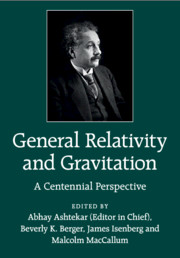Book contents
- Frontmatter
- Contents
- Preface
- List of contributors
- List of figures
- List of tables
- Part One Einstein's Triumph
- Part Two New Window on the Universe: Gravitational Waves
- 5 Receiving Gravitational Waves
- 6 Sources of Gravitational Waves: Theory and Observations
- Part Three Gravity is Geometry, after all
- Part Four Beyond Einstein
- Index
- References
6 - Sources of Gravitational Waves: Theory and Observations
from Part Two - New Window on the Universe: Gravitational Waves
Published online by Cambridge University Press: 05 June 2015
- Frontmatter
- Contents
- Preface
- List of contributors
- List of figures
- List of tables
- Part One Einstein's Triumph
- Part Two New Window on the Universe: Gravitational Waves
- 5 Receiving Gravitational Waves
- 6 Sources of Gravitational Waves: Theory and Observations
- Part Three Gravity is Geometry, after all
- Part Four Beyond Einstein
- Index
- References
Summary
Historical perspective
James Clerk Maxwell discovered in 1865 that electromagnetic phenomena satisfied wave equations and found that the velocity of these waves in vacuum was numerically the same as the speed of light [1]. Maxwell was puzzled at this coincidence between the speed of light and his theoretical prediction for the speed of electromagnetic phenomena and proposed that “light is electromagnetic disturbance propagated through the field according to electromagnetic laws” [1].
Because any theory of gravitation consistent with special relativity cannot be an action-at-a-distance theory, in many ways, Maxwell's theory, being the first relativistic physical theory, implied the existence of gravitational waves (GWs) in general relativity (GR). Indeed, years before Einstein derived the wave equation in the linearised version of his field equations and discussed the generation of GWs as one of the first consequences of his new theory of gravity [2,3], Henri Poincaré proposed the existence of les ondes gravifiques purely based on consistency of gravity with special relativity [4]. However, for many years GWs caused much controversy and a lot of doubt was cast on their existence [5-8]. The year 1959 was, in many ways, the turning point – it was the year of publication of a seminal paper by Bondi, Pirani and Robinson [6] on the exact plane wave solution with cylindrical symmetry and the energy carried by the waves [9]. This paper proved that wave solutions exist not just in the weak-field approximation and that GWs in GR carry energy and angular momentum away from their sources. These results cleared the way for Joseph Weber [10] to start pioneering experimental efforts. The discovery of the Hulse–Taylor binary [11], a system of two neutron stars in orbit around each other, led to the first observational evidence for the existence of gravitational radiation [12]. The loss of energy and angular momentum to GWs causes the two stars in this system to slowly spiral in towards each other.
- Type
- Chapter
- Information
- General Relativity and GravitationA Centennial Perspective, pp. 287 - 346Publisher: Cambridge University PressPrint publication year: 2015
References
- 16
- Cited by

